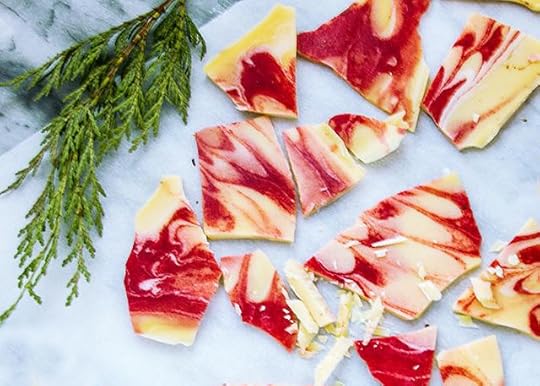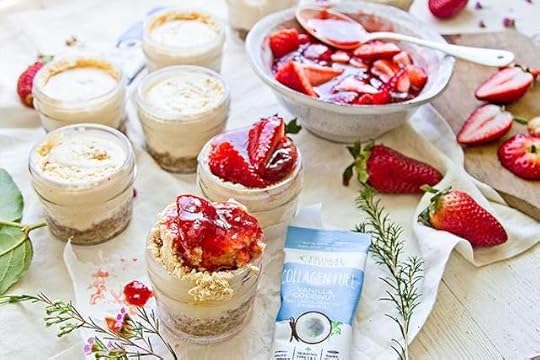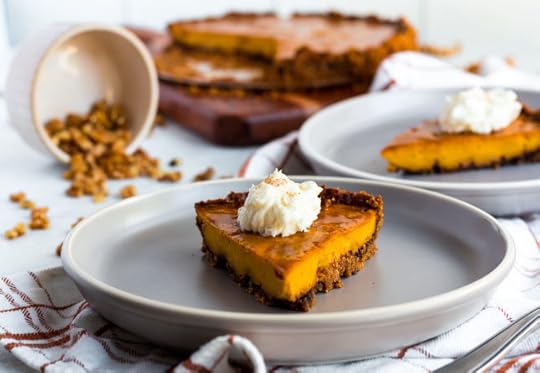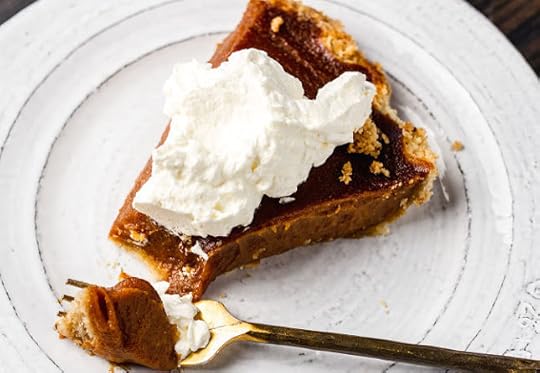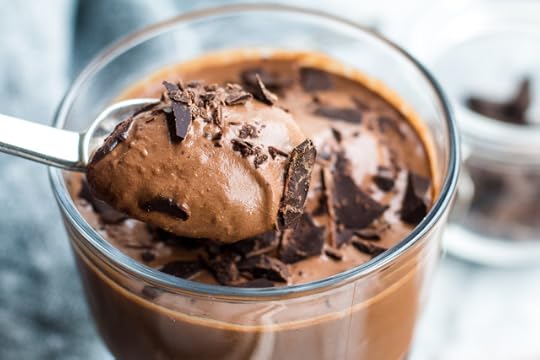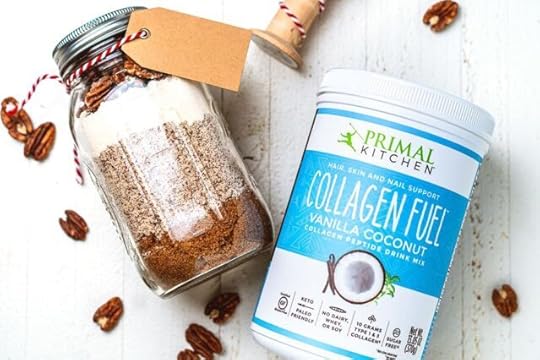Mark Sisson's Blog, page 87
December 12, 2019
13 Holiday Desserts
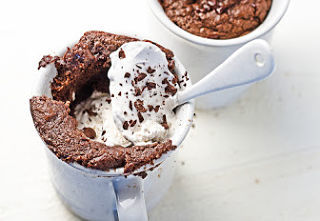 Although our holiday menus revolve around the delicious meats and savory sides, there’s still a soft spot for many of us when it comes to holiday sweets. Whether it’s baking cookies this time of year or serving show-stopping desserts at our holiday tables, we might give a little more leeway for treats as part of the special occasion. Below we’ve got recipes for every taste and preference—from Primal to keto, chocolate to peppermint, candy to mousse, pie to cheesecake…and even a jarred Primal cookie mix for gift-giving. Enjoy, and let us know what treats you’ll be baking and sharing this holiday.
Although our holiday menus revolve around the delicious meats and savory sides, there’s still a soft spot for many of us when it comes to holiday sweets. Whether it’s baking cookies this time of year or serving show-stopping desserts at our holiday tables, we might give a little more leeway for treats as part of the special occasion. Below we’ve got recipes for every taste and preference—from Primal to keto, chocolate to peppermint, candy to mousse, pie to cheesecake…and even a jarred Primal cookie mix for gift-giving. Enjoy, and let us know what treats you’ll be baking and sharing this holiday.
1. Hazelnut Chocolates
2. Primal (or Keto) Fudgy Brownies
3. Keto Peppermint Bark
4. Keto Coconut Cheesecake
5. Cranberry Orange Olive Oil Cake
6. Low Carb Mug Cake

7. Pumpkin Pie
8. Sweet Potato Pie
9. Sweet Potato Custard
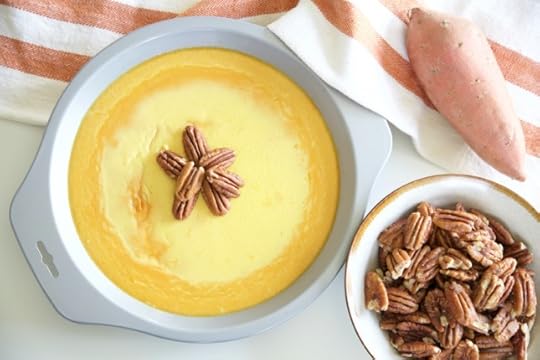
10. Chocolate Collagen Pudding
11. Mexican Hot Chocolate
12. Keto Fridge Fudge
13. Pecan Sandie Cookie Mix In a Jar
Thanks for stopping in, everyone. What Primal or keto treats will you be serving this holiday? Let us know on the comment board.

The post 13 Holiday Desserts appeared first on Mark's Daily Apple.



December 11, 2019
14 Scenarios When Fasting Might Be Your Best Approach
 There’s a ton of talk about intermittent fasting in the ancestral heath sphere for general health and wellness as well as weight loss, but little indication of specific applications for the practice. Anytime you attempt a “radical” health practice like not eating, it helps to have a good reason to do it. That will not only give you something to aim for, but it will ensure you actually have a physiological justification for your experiment. Never go in blind.
There’s a ton of talk about intermittent fasting in the ancestral heath sphere for general health and wellness as well as weight loss, but little indication of specific applications for the practice. Anytime you attempt a “radical” health practice like not eating, it helps to have a good reason to do it. That will not only give you something to aim for, but it will ensure you actually have a physiological justification for your experiment. Never go in blind.
What are some of the specific scenarios and conditions where fasting makes the most sense?
1. You Are Intractably, Morbidly Obese
It used to be that an accepted and well-tested fix for morbid obesity that was unresponsive to other methods was long term fasting.
One experiment was very long term: over a year of not eating anything except for multivitamins. (Disclaimer: I’m not recommending this approach, but it is interesting.)
Back in 1965, an obese Scotsman of 27 years and 456 pounds came to the Department of Medicine in Dundee, Scotland, with a problem. He needed to lose weight. A (1/8 of a) ton of it. The doctors suggested maybe not eating for a few days could help. It was just an offhand recommendation, but the Scotsman really took to it. He stayed at the hospital for several days, taking only water and vitamin pills while undergoing observation to ensure nothing went wrong. When his time was up, he continued the fast back at home, returning to the hospital only for regular monitoring. After a week, he was down five pounds and feeling good. His vitals checked out, blood pressure was normal, and though he had lower blood sugar than most men, he didn’t seem particularly impaired by it. The experiment continued… for 382 days.
Yes, AB fasted for 382 days, drinking only water and taking vitamin, potassium, and sodium supplements. All told, he lost 276 pounds, reaching his target weight of 180 pounds and maintaining the bulk of his weight loss. Over the five following years of observation, AB regained just sixteen pounds, putting him in excellent, but underpopulated territory (at least 80% of dieters eventually regain all the lost weight).
2. You Want the Benefits Of Ketosis Without Having To “Go Keto”
One thing a fast of sufficient length will do is throw you straight into ketosis. Humans are so wired to go into ketosis that a simple overnight “fast,” aka sleeping, will do it.
Then, when you do eat, you have more wiggle room on carbs because you’ve just spent plenty of time in ketosis during the fast. This isn’t the same thing as going keto, but then again, not everyone wants to be in ketosis all the time. Many benefits come from “dipping in and out of ketosis” on a regular basis, and regular intermittent fasting certainly qualifies.
3. You’re Otherwise Quite Lean, Active, and Low-Stress and Just Have a Little Bit To Lose
Fasting can be a stressor. Going without food tends to do that in organisms that rely on food for sustenance. It’s just that in the context of an overall low-stress lifestyle and low-oxidative stress physiology, it can be a positive stressor—a stressor that promotes strength and adaptation.
This is why women, in general, tend to have a tougher time with long term fasting. They are inherently more vulnerable to nutritional stressors since they have to be prepared to carry children to term and nurse them, two functions that require a steady source of calories. Biologically speaking, that is.
4. You Want a Buffer Against Degenerative Diseases
Now, this is mostly speculative. This isn’t medical advice or a guarantee of any kind. There’s good reason to believe that regular extended fasting (or at least skipping meals/multiple meals on a regular basis) can reduce the risk of degenerative diseases and perhaps even extend life by triggering the autophagy pathway that cleans up damaged cells and keeps pre-cancerous cells suppressed.
Will this ensure you don’t get cancer down the line or die earlier than is your potential? No, not at all. But it’s a relatively easy thing to try with no downside, and it just might help.
5. You Want To Lean Out and Gain Muscle At the Same Time
The classic Leangains-style intermittent fasting with regular strength training is one of the best ways I’ve ever found to gain muscle and lose body fat concurrently. You follow a shortened eating window every day—usually 16 hours fasting, 8 hours eating—and on workout days end the fast with a strength training workout, then eat. Classic Leangains has you eating lower fat, higher carb on workout days and higher fat, lower carb on rest days, with protein kept high throughout. But it should work on whatever macro combination you prefer.
You won’t gain as much muscle as quickly as if you ate enormous meals all the time, but the gains you make will generally be leaner.
6. You’re Recovering From Major Gut Issues
A friend of mine just did a 5-day water fast to reset his gut biome after SIBO and/or a parasitic invasion. It fixed him right up. And whenever my dogs have ever had digestive upset, like diarrhea or something, I’ll throw them on a two-day fast and they bounce right back.
I think the gut needs periodic “resets” to stay in top shape. Give it a rest, have nothing go through demanding its attention for a couple days, and allow things to balance out. Just like someone who trains all the time can really benefit from a deload week, a digestive system that’s constantly digesting and processing food can benefit from a day or two of rest.
7. You Want To Control Blood Glucose Levels
In men with an elevated risk of getting type 2 diabetes, intermittent fasting without consciously changing what or how much they ate improved blood glucose levels. They either ate from noon to 9 PM or from 8 AM to 5 PM, so a solid nine hour eating window was enough to trigger improvements. That they didn’t change what they ate suggests that irrespective of the quality or quantity of the diet, simply not eating for 15 hours a day will improve your metabolic health.
Dr. Jason Fung consistently uses intermittent fasting in his patients with type 2 diabetes, so the potential for powerfully therapeutic effects for even full blown type 2 diabetes is quite high.
8. You Only Have Access To Terrible Food
When I travel for business, which is quite often, I tend to fast. Airports are getting better, but it’s still a sad state of culinary affairs. I usually have a few choices: I can pick at a wilted Caesar salad with flaccid chicken breast. I can eat some congealed beef patties from whatever fast food joint has set up shop in the terminal. I can drop $30 for a mediocre steak. Or I can just fast.
I usually choose the last option. At this point in my life, I refuse to put substandard food into my body, especially if it isn’t even very delicious. I’d rather just skip the food entirely and have a great meal when I arrive.
9. You Can’t Stop Snacking
Total freedom is hard for some people to manage. Even if the food is high quality and Primal or keto or whatever, constant access to eternal amounts of it is hard to turn down. Snacking happens. Again and again. Sometimes, we need to put up barriers to manage that freedom, to make it work. After all, paradise is a walled garden, and erecting the artificial eating barrier of a full-on fasting day (or two) or a compressed eating window will allow you to overcome this. If this describes you, a fasting regimen just might be the trick to work.
Plus, many people find that forcing yourself to not eat for an extended amount of time on a regular basis upregulates fat burning machinery and allows better eating habits and reduced snacking when you do go back to normal eating.
10. You’re Willing To Try an Unconventional Recovery Technique
When Dude Spellings was on the podcast, he relayed a wild story about racing 50 miles through the Grand Canyon in a (mostly) fasted state, being greeted at the finish line with a stack of pizzas, and instead of wolfing down with all the other competitors, continuing the fast through till the next day—theorizing that in his exhausted, inflamed state he could use the benefits of cell repair and anti-inflammatory processes enhanced by fasting. He woke feeling less stiff and sore than his previous crossing 13 years prior.
11. You’re Trying To Avoid Jet Lag
Another reason I often fast when traveling is to establish a new circadian rhythm aligned with my destination. By waiting until the morning after my arrival to eat, I take advantage of one of the most powerful stimuli, or zeitgebers, for establishing a new circadian rhythm: food. Eat a big meal in the morning, and your body “knows” it’s morning—biologically speaking.
How this looks:
I arrive at noon in the new location, which feels like nighttime for me. Instead of eating a big “lunch” and collapsing into bed, I spend all day staying active and fasting. I skip dinner. I walk everywhere. Then, in the morning, I get a workout in, preferably outdoors to get natural light exposure, and follow up with a big breakfast. That combo—the light, the workout, and the breakfast eaten at my desired breakfast time in the new place—sets my internal clock and minimizes jet lag.
12. You’re a Shift Worker
Shift workers are at an increased risk of many diseases, like diabetes and breast cancer, and a lot of this comes down to the disordered eating they’re often forced to engage in. They eat in the middle of the night, when their body wants to be sleeping, and in doing so throw their circadian rhythm out of wack more than it already is going to be.
If you’re primarily awake in the middle of the night but want to maintain a semblance of circadian rhythm, it makes sense to eat at normal dinner time and at the end of your shift, but not during. Fasting during your shift might just be the big breakthrough.
13. You’re Undergoing Chemotherapy
It’s common knowledge that calorie restriction can improve the response to chemotherapy while reducing the negatives. Fasting is just a more reliable, arguably easier version of calorie restriction. There’s even evidence that fasting can improve your healthy cells’ resistance to chemotherapy while reducing the cancer cells’ resistance while reducing negative symptoms like nausea and vomiting.
Don’t consider this medical advice, but do discuss it with your doctor. This info is resonating across the oncology world; it’s getting harder to deny that many patients can benefit from intermittent fasting.
14. You’ve Got a Massive Feast Coming Up
If you have a history of eating disorders, this is probably unwise. The feast/fast method can be taken to unhealthy levels, especially if it’s couched in feelings of body dissatisfaction or deep childhood trauma. But if these aren’t an issue and you have a one-off feast (like a holiday dinner) you simply want to really dig into, fasting for a day before the big feast can enhance the effects of the feast.
Whenever I hit the Brazilian all-you-can-eat BBQ joint, I’ll fast for at least a day—just to get my money’s worth and really develop that insatiable, salivating, Primal urge to eat meat. Hunger is the best spice.
These aren’t even all the scenarios where fasting helps or makes sense. There are others, which is where you come in. What have been your reasons for fasting? Has it worked?
Thanks for reading, everyone. Take care!

The post 14 Scenarios When Fasting Might Be Your Best Approach appeared first on Mark's Daily Apple.



December 10, 2019
The Definitive Guide to Tea
 Tea can mean a lot of different plants. There’s maté, the bitter South American shrub steeped in boiling water to extract the caffeine-like compounds contained within. There’s rooibos, the “red tea” made from a polyphenol-rich bush native to South Africa. There’s coca, the South American plant also used to make cocaine. There are the unnamed wild bitter root and herb teas used by the Maasai, the evergreen tip teas used by American natives to obtain vitamin C, the nettleleaf teas used across Europe.
Tea can mean a lot of different plants. There’s maté, the bitter South American shrub steeped in boiling water to extract the caffeine-like compounds contained within. There’s rooibos, the “red tea” made from a polyphenol-rich bush native to South Africa. There’s coca, the South American plant also used to make cocaine. There are the unnamed wild bitter root and herb teas used by the Maasai, the evergreen tip teas used by American natives to obtain vitamin C, the nettleleaf teas used across Europe.
For today’s post, I’m focusing on the actual tea plant—Camellia sinensis. All of the classic teas come from the same basic plant; the differences lie in how they’re processed after harvest. Most tea undergoes controlled oxidation to develop flavor and different bioactive compounds. The more oxidized, the darker the tea. The less oxidized, the lighter.
I’m also going to focus on the health benefits of tea, rather than get into the nitty gritty of tea grading, the endless bespoke varieties, the optimum temperature—tea expert stuff. I enjoy tea, but I’m not a connoisseur. I can tell you about the health effects, and I imagine that’s what most of you are here for anyway.
Types Of Tea
Even within “true tea,” there are multiple varieties.
White Tea
White tea is made from tea leaves that are very lightly processed without any oxidation. Studies show that it’s “lower” in antioxidants than green or oolong tea, but that doesn’t mean it’s “worse.”
White tea possesses compounds that inhibit the absorption and digestion of glucose, thereby lowering blood glucose levels.
White tea also shows a unique ability to fight amyloid plaque linked to Alzheimer’s disease (albeit in test tubes, not live people so far).
Green Tea
In Japan, green tea is lightly steamed. In China, it’s quickly toasted under dry heat. The result with each is light oxidation. It has a “grassy” flavor and, in general, the most antioxidant content—the catechins. In one study looking at the antioxidant content and effect of 30 different teas, the top 2 and 6 of the top 10 were green teas.
Most studies find that green tea is associated with the most health benefits among all the teas, but I take that with a grain of salt. For instance in this study, green tea was associated with better health outcomes than black tea among adults in the Mediterranean, but they failed to control for physical activity. Green tea drinkers had more physical activity, which the authors suggest is a benefit of green tea but I suggest is a feature of the “healthy user effect.” Green tea drinkers did more healthy stuff like exercise, while black tea drinkers were less likely.
There are consistent links between green tea and lower cognitive decline. We don’t see this as much in other teas (or coffee, for that matter).
Oolong Tea
Oolong is “halfway between” green tea and black tea: more heavily oxidized than green, less oxidized than black. Oolong also ranks highly for antioxidant content; in that same 30-tea antioxidant study, oolongs took 4 of the top 10 spots.
Black Tea
Black tea is fully-oxidized tea. It’s the highest in caffeine and rich in a class of antioxidants known as theaflavins.
Theaflavins in the 50-100 mg range (4-8 cups of black tea) reduced body fat and increased muscle mass in Japanese women, while green tea catechins had no effect.
Pu-erh Tea
Pu-erh tea undergoes an additional level of microbial fermentation. It develops intense flavors and unique bioactive compounds.
For example, pu-erh contains alpha-amylase and alpha-glucosidase inhibitors that reduce the absorption of dietary glucose and lower blood glucose levels, particularly after eating.
Animal studies show protective effects against metabolic syndrome, hyperglycemia, obesity, and fatty liver. It seems to reduce liver fat, but by a strange mechanism: by increasing de novo lipogenesis (fat creation) in the visceral adipose tissue. Rodents in the study lost weight but gained visceral fat.
Matcha Tea
Matcha green tea is made from powdered, shade-grown tea leaves. Well, “shade-finished” might be a more accurate descriptor; a few weeks before the harvest, matcha-designated tea plants are covered with shade. This slows the growth, sweetens and deepens the flavor, and increases the amino acid content of the leaves (specifically L-theanine). Pulverizing the tea leaves into a powder increases the surface area and makes for a stronger, more potent brew. Plus, when you drink matcha, you’re consuming the leaves and all their polyphenols and amino acids themselves. The powder doesn’t get strained out like normal green tea leaves.
This seems to increase the antioxidant activity. First, there’s more L-theanine available. I’ve discussed the stress-reducing benefits of L-theanine before, but it’s also good against anxiety and pairs well with caffeine (more on that later). Plus, a 2003 study found that the epigallocatechin gallate (EGCG) was 137 times more bioavailable in matcha than a traditional leaf-based green tea, and more than three times as bioavailable as the “largest literature value of other green teas.” My guess is that the increased bioavailability is explained by the fact that you’re consuming the powdered tea itself rather than steeping and discarding the leaves. Another advantage of matcha is that because it’s so potent, you need much less of it, rendering any of the potential downsides of tea, like fluoride content, less troublesome.
(Can you tell that matcha is my favorite?)
The Health Benefits Of Tea
In general, tea is a rich source of bioactive polyphenols with suspected health benefits. Some of the potential anti-cancer effects reported by the study:
Chronic obstructive lung disease (COPD): In Korea, drinking more than two cups a day of green tea was linked to lower rates of COPD.
Colon cancer: Among Korean patients who’d had colorectal adenomas (benign tumors) removed, taking green tea extract reduced the recurrence of them at one-year post surgery.
Prostate cancer: In Hong Kong, green tea consumption was linked to a reduced risk of prostate cancer. However, follow-up controlled trials in men with prostate cancer had mostly null results.
Skin cancer: Among whites, both caffeinated coffee and tea consumption were linked to protection against basal cell carcinoma (although coffee had the stronger relationship).
Most of the cancer studies in humans are merely observational. More interesting are some of the other effects.
Most tea varieties have mild anti-hyperglycemic effects, most likely caused by the ubiquity of substances that inhibit the effect of glucose digesting and absorbing enzymes. In other words, drinking some tea with your meal will generally reduce the amount of carbs you absorb.
Tea polyphenols are among the best at inducing a beneficial hormetic response—the one where your body responds to the presence of “toxins” by upregulating its own defense capabilities and triggering a net beneficial cascade of health effects. It’s up there with coffee, chocolate, and red wine. Green tea, for example, triggers the Nrf2 pathway, causing an increase in glutathione and other antioxidant pathways our bodies use to reduce oxidative stress and nullify reactive oxygen species.
The (Few) Negatives To Look Out For…
Fluoride
I’ve covered fluoride before, and I’m still not sure of it. It seems to have some benefits for topical application to teeth, but systemic ingestion poses problems. For instance, women who consumed the most fluoridated water (and tea) during pregnancy give birth to kids with depressed IQs. Tea is very high in fluoride. The plant itself is quite good at yanking fluoride from the soil, and soil fluoride in tea-producing countries is on the rise due to industrial pollution.
High quality tea made from younger leaves is more likely to be lower in fluoride, since the plant won’t have had as much time to deposit soil fluoride into the leaves. The lowest quality, cheapest brick tea is made from the oldest leaves and will be higher in fluoride.
White tea is generally low in fluoride, since the leaves are picked when still very young. Green, oolong, and black tea leaves all stay on the plant long enough to pick up measurable levels of fluoride.
In Ireland, the only European country with legally mandated water fluoridation, the average fluoride content of brewed tea was 3.3 mg/L, with the highest levels hitting 6 mg/L. Based on Irish tea consumption, the authors suggest that “the majority of the population in Ireland are at risk of chronic fluoride intoxication.”
Organic Japanese-grown matcha green tea is a good option for fluoride minimization, as Japanese soil tends to be quite low in fluoride.
Microplastics
If you use plastic tea bags, your tea will be full of microplastics. Stick to loose leaf or paper tea bags.
How to Brew It
Okay, so how should you brew your tea?
Duration: If you’re trying to maximize antioxidant extraction, longer is better.
In one study of bagged and loose leaf black tea, longer brew times extracted more antioxidants.
For bagged tea, 5 minutes produced the most antioxidants.
For loose leaf tea, 60 minutes produced maximum extraction. However, the first 10-15 minutes were where the vast majority of antioxidants were obtained. Longer brew times extracted more, but the rate of extraction dropped off a cliff. The difference between 15 minutes of brewing and 60 minutes of brewing probably isn’t enough to justify waiting an hour for your tea.
Water choice: A recent study compared green and black tea brewed with three different waters: tap, bottled, and deionized. Tap water with higher levels of minerals produced the best tasting tea with the lowest amount of antioxidants. Bottled and deionized water with lower levels of minerals extracted the most bitter compounds, leading to a higher antioxidant level but harsher taste.
Water temperature: I’ve read and heard a lot of different “rules” for brewing tea. Some say to “never boil the water.” Others say the opposite. All I know is that I’ve never noticed a big difference—but I’m no expert. What I do know is that both low and higher water temperatures seem to extract and preserve a good amount of antioxidant content:
In the black tea study above, they used water at 80 degrees C or 176 degrees F. That’s well below boiling.
In the study comparing 30 varieties of green, black, oolong, white, and pu-erh teas, they used water at 98 degrees C or 208 degrees F. That’s almost boiling.
A Few Ways To Enjoy It
Collagen Matcha Latte: Read this post for directions.
Coffee Matcha: Sometimes I’ll make a batch of French press coffee and throw a spoonful of matcha powder in with the grounds. I’ll add some hot heavy cream to the brew. This is a great way to get caffeine and L-theanine at once, a synergistic combo shown to improve cognitive performance. Many find that theanine takes the jitter away from the caffeine buzz.
Creamy Turmeric Tea: Read this post, and add some black tea.
And…I’ve got a couple new ways that takes the work out of the above. For those looking to get out the door quickly in the morning, tea in hand, check out the new Primal Kitchen® Matcha Keto Collagen Latte and Chai Keto Collagen Latte. I’m excited about them. Let me know what you think.
Summing It Up
Like everything else, tea is no super-substance that will save you from cancer, diabetes, and obesity. But it’s a drink that’s consistently (and sometimes causally) associated with better overall health, has a long tradition of usage, and can complement an otherwise healthy diet and lifestyle. All teas appear to have some benefits, so drink what you like most.
What kind of tea do you drink? How do you make it? How do you take it?
Thanks for reading, everyone. Take care!

The post The Definitive Guide to Tea appeared first on Mark's Daily Apple.



December 9, 2019
I’m Confident My Lifestyle Will Pay Dividends
It’s Monday, everyone! And that means another Primal Blueprint Real Life Story from a Mark’s Daily Apple reader. If you have your own success story and would like to share it with me and the Mark’s Daily Apple community please contact me here. I’ll continue to publish these each Monday as long as they keep coming in. Thank you for reading!

Yup, success stories are back! And I’m looking for more. Follow-ups, mid-progress reflections—every story at every stage has the potential to inspire folks out there who are getting started or contemplating a new beginning. Contact me here to share your story—long or not so long. You never know who you’ll impact by doing it. Enjoy, everyone!
My success story isn’t one of weight loss amazement, but it’s still about an overall remake. Tyler version 2.0, I guess. My Primal path started about four years ago because I simply got fed up with feeling gross and tired. I had some friends and social media acquaintances who often touted the benefits of Paleo living and how eating real food made such a difference for them. I was skeptical. At the time, I remember being on a kick of eating more rice because I thought, “healthy carbs in large quantities are surely a good thing.” But on a Saturday morning in March of 2015 I told my wife I had had enough of feeling like garbage.
The next day I went to the grocery store on a Primal shopping mission. I loaded up on meats, fruits, and veggies with the determination to eat from those three categories for two weeks. If I didn’t like it or didn’t find it helpful, then I’d find a plan B. Well I’m still on Plan A, thank heavens. I went through the carb flu and came out on the other side intact. Yes, I had a couple of cheat moments those two first weeks, but I kept the 80/20 rule in mind and didn’t beat myself up over it. Heck, I still don’t!
Like others, I reveled in the fact that I could indulge in eating almost endless amounts of glorious meat (and fatty goodness), yet not gain weight or feel lethargically disgusting like I did when eating mounds of pasta, pizza, or other SAD foods. It was so wonderful to not count calories or watch my portions while on this new “diet” I was trying. The diet became a passion, and it became pretty darn easy. I went through the phase of telling everyone else they were eating wrong and that Primal was the only way. They didn’t all listen. Bizarre, I know. So I adapted to quietly telling the benefits of my lifestyle when asked, but I stopped shouting it from the mountaintop.
Fast forward to 2017 when I was diagnosed with Crohn’s disease. Without yet knowing my preferred diet, my doctor gave a short sermon on how I’d have to radically shift my lifestyle away from a normal Western diet and avoid processed foods. When I told him of my Primal ways, he gave me a nod of approval knowing I was already on the right track. Having Crohn’s is a little scary (and many other people have ailments way worse, I know), but knowing my diet and lifestyle were already strong helped me feel a little more at ease. I still take the prescribed medication, but I’m confident my lifestyle will pay dividends in the long term helping me avoid heavier-duty prescriptions, surgeries, etc. And I now look back at my early days with even more gratitude for you and other Primal/Paleo advocates. You gave me something healthy, sustainable, and satisfying that I can use for the rest of my life.
In March of 2015 I weighed a little over 180 pounds and now weigh in around 165. I feel good, like this is what was meant for my body. Now in my early thirties, I am confident I won’t get that “dad bod” I was worried I’d someday have to face. I still eat mostly meats, fruits, veggies, and nuts and seeds. I don’t worry about missing meals or having all the food groups in that pyramid thingy. I lift heavy things and run up the hill in my yard just for a short sprint now and then. Because why not. I am not perfect – I don’t have a workout routine, I should probably eat even more veggies, and I still partake in non-Primal indulgences like beer or a half pan of brownies in a moment of weakness. Yeah, I could try harder, but I’m happy and I like this version of me. And I’m excited for the growth that might just yet come.
Thanks, Tyler


The post I’m Confident My Lifestyle Will Pay Dividends appeared first on Mark's Daily Apple.



December 8, 2019
Cranberry Orange Olive Oil Cake
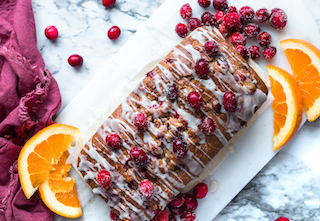 Whether you’re hosting guests or you’re just looking to serve a little something special for after dinner, we love this lower carb version of a classic favorite this time of year: cranberry orange olive oil cake. Tart and sweet flavors blend beautifully in this soft pound cake that you’ll love to present. It’s a feast for the eyes—and a treat for any taste.
Whether you’re hosting guests or you’re just looking to serve a little something special for after dinner, we love this lower carb version of a classic favorite this time of year: cranberry orange olive oil cake. Tart and sweet flavors blend beautifully in this soft pound cake that you’ll love to present. It’s a feast for the eyes—and a treat for any taste.
The cake itself is versatile and lends itself to a variety of flavors. Swap out the orange and cranberry to make other types of cake, like lemon and raspberry. You can also add your favorite chopped nuts for added texture.
Tip: If you’re unsure about the sweetness of the cake, leave the eggs out of the wet ingredients. Once you mix the dry and wet ingredients together, adjust the sweetener to taste. After that, whisk the eggs into the batter and pour the batter into the baking dish.
We made this cake as a pound cake in a loaf pan, but it can also be made in a round or square pan.
Servings: 12
Prep Time: 15 minutes
Cook Time: 45 minutes
Ingredients:
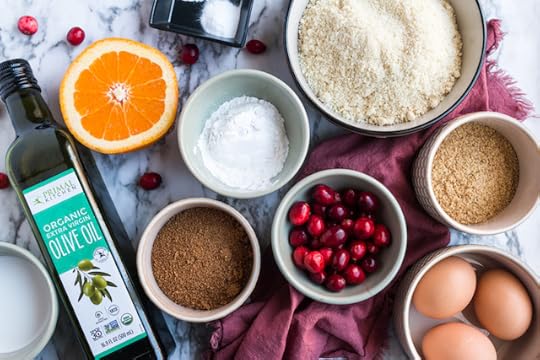
2 cups almond flour
½ cup coconut sugar, Swerve or granular monk fruit sweetener
¼ cup ground flaxseed
¼ cup tapioca starch
1 tsp. baking powder
½ tsp. baking soda
Pinch of salt
½ cup Primal Kitchen® Organic Olive Oil
¼ cup coconut milk
3 eggs
1 Tbsp. orange juice
½ tsp. vanilla extract
Zest from ½ orange
½ cup fresh cranberries
Drizzle (optional): melted coconut butter + coconut milk to thin
Instructions:

Preheat your oven to 325 degrees Fahrenheit. In a large bowl, combine the almond flour, sweetener, flaxseed, tapioca starch, baking powder, baking soda and salt. In another bowl, combine the olive oil, coconut milk, eggs and vanilla extract. Combine the ingredients and whisk until well mixed. Add in the orange juice, orange zest and cranberries.

Pour the batter into a parchment-lined loaf pan. Bake for 45-50 minutes or until the top is golden and a toothpick comes out clean or the internal temperature on a food thermometer reads about 190 degrees Fahrenheit. Allow the bread to cool.
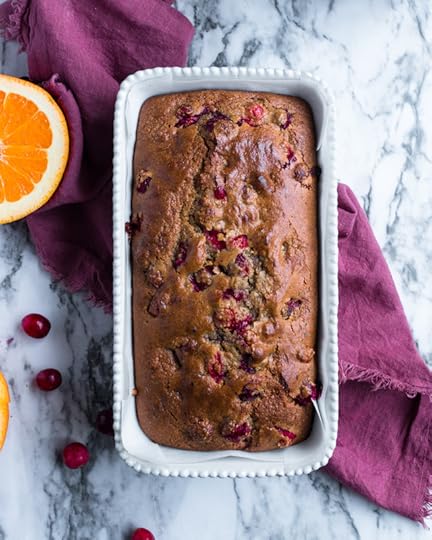
If you are making a glaze, combine coconut butter with a small amount of coconut milk or milk of choice until it reaches your desired thickness. You can also add a squeeze of orange juice.
Drizzle the glaze on top before slicing and serving.

Nutrition Information with Swerve (1/12 of recipe):
Calories: 240
Total Carbs: 7 grams
Net Carbs: 4 grams
Fat: 22 grams
Protein: 6 grams
Nutrition Information with Coconut Sugar (1/12 of recipe):
Calories: 270
Total Carbs: 15 grams
Net Carbs: 12 grams
Fat: 22 grams
Protein: 6 grams

The post Cranberry Orange Olive Oil Cake appeared first on Mark's Daily Apple.



December 6, 2019
Weekly Link Love — Edition 58

Research of the Week
Time-restricted eating improves body composition, weight loss, blood lipids, blood pressure, and sleep quality in patients on statins.
Social media abstinence fails to produce improvements in psychological well-being.
Using springy bamboo poles makes it easier to carry more than your bodyweight.
The more you run each week, the lower your omega-3 index. Runners, eat your fatty fish.
New Primal Blueprint Podcasts

Episode 392: Elle Russ: Elle Russ switches seats.

Primal Health Coach Radio, Episode 37: Laura and Erin chat with Ashley Suave about the importance of sunk cost.
Each week, select Mark’s Daily Apple blog posts are prepared as Primal Blueprint Podcasts. Need to catch up on reading, but don’t have the time? Prefer to listen to articles while on the go? Check out the new blog post podcasts below, and subscribe to the Primal Blueprint Podcast here so you never miss an episode.
Media, Schmedia
Interesting Blog Posts
Developed countries with access to supplements and medicine and a backdrop of lifelong animal consumption might get away with plant-based diets for a little while, but what about the kids growing up in developing nations?
Losing weight with croissants.
Social Notes
A proposition.
Everything Else
Fattitude, a keto restaurant, opens in Boise, Idaho.
How do parents of young children manage different risk tolerance setpoints?
Things I’m Up to and Interested In
Event I’d love to attend if I had the time: Craig and Maria Emmerich’s keto spa retreat.
Line I found interesting: “Heart failure is rapidly increasing in incidence and is often present in patients receiving long-term statin therapy.”
I’m not surprised: First genetic evidence of human self-domestication.
Ancestral American food almost no one is eating anymore: Raccoon.
And in this corner: The case for more sleep.
Question I’m Asking
Last week, I posted a critique of “Why We Sleep.” This week, I posted a link arguing for the importance of sleep. What is your experience with getting more or less sleep?
Recipe Corner
Another winner from Nom Nom paleo: tangy slaw.
New to fermentation? Try garlic dill pickles.
Time Capsule
One year ago (Nov 30– Dec 6)
Low-Carb Mulled Wine – An ancient libation.
Does Bone Broth Break a Fast?– Well, does it?
Comment of the Week
“I really enjoyed reading about the 82-year-old woman who beat up an intruder. Threw a table at him and broke the table, poured a bottle of shampoo on his head, hit him with a broom. I love this woman.”
– Me too, TGJ.

The post Weekly Link Love — Edition 58 appeared first on Mark's Daily Apple.



December 5, 2019
A Beginner’s Guide to Reading Scientific Research
 Scientific journal articles can be incredibly intimidating to read, even for other scientists. Heck, I have a Ph.D. in a research science and have authored scientific papers, but sometimes I look at a research report outside my field of study and just go, “Nope, can’t decipher this.”
Scientific journal articles can be incredibly intimidating to read, even for other scientists. Heck, I have a Ph.D. in a research science and have authored scientific papers, but sometimes I look at a research report outside my field of study and just go, “Nope, can’t decipher this.”
Learning to read them is an important skill, however, in today’s environment of what I call “research sensationalism.” This is where the popular media gets hold of a scientific research report and blows the findings WAY out of proportion, usually while misrepresenting what the researchers actually did and/or found. You know what I’m talking about.
Unfortunately, you can’t trust popular media reports about scientific research studies. Too often, it’s shockingly evident that the people writing these reports (a) aren’t trained to evaluate scientific research, and (b) are just parroting whatever newswire release they got that morning with no apparent fact-checking.
Thus, if staying informed is important to you—or you just want to be able to shut down all the fearmongers in your life—you need to learn how to read the original journal articles and form your own judgments. You don’t have to become an expert in every scientific field, nor a statistician, to do so. With a little know-how, you can at least decide if the popular media reports seem accurate and if any given study is worth your time and energy.
Where to Begin
First things first, locate the paper. If it’s behind a paywall, try searching Google Scholar to see if you can find it somewhere else. Sometimes authors upload pdfs to their personal webpages, for example.
Ten years ago, I would have told you to check the journal’s reputation next. Now there are so many different journals with different publishing standards popping up all the time, it’s hard to keep up. More and more researchers are choosing to publish in newer open access journals for various reasons.
Ideally, though, you want to see that the paper was peer reviewed. This means that it at least passed the hurdle of other academics agreeing that it was worth publishing. This is not a guarantee of quality, however, as any academic can tell you. If a paper isn’t peer reviewed, that’s not an automatic dismissal, but it’s worth noting.
Next, decide what type of paper you’re dealing with:
Theoretical papers
Authors synthesize what is “known” and offer their own interpretations and suggestions for future directions.
Rarely the ones getting popular press.
Great if you want to know the new frontiers and topics of debates in a given field.
Original research, aka empirical research
Report the findings of one of more studies where the researchers gather data, analyze it, and present their findings.
Encompasses a wide variety of methods, including ethnographic and historical data, observational research, and laboratory-based studies.
Meta-analyses & systematic reviews
Attempt to pool or summarize the findings of a group of studies on the same topic to understand the big picture.
Combining smaller studies increases the number of people studied and the statistical power. It can also “wash out” minor problems in individual studies.
Only as good as the studies going into them. If there are too few studies, or existing studies are of poor quality, pooling them does little. Usually these types of reports include a section describing the quality of the data.
Since popular media articles usually focus on empirical research papers, that’s what I’ll focus on today. Meta-analyses and reviews tend to be structured in the same way, so this applies to them as well.
Evaluating Empirical Research
Scientists understand that even the best designed studies will have issues. It’s easy to pick apart and criticize any study, but “issues” don’t make studies unreliable. As a smart reader, part of your job is to learn to recognize the flaws in a study, not to tear it down necessarily, but to put the findings in context.
For example, there is always a trade-off between real-world validity and experimental control. When a study is conducted in a laboratory—whether on humans, mice, or individual cells—the researchers try to control (hold constant) as many variables as possible except the ones in which they are interested. The more they control the environment, the more confident they can be in their findings… and the more artificial the conditions.
That’s not a bad thing. Well-controlled studies, called randomized control trials, are the best method we have of establishing causality. Ideally, though, they’d be interpreted alongside other studies, such as observational studies that detect the same phenomenon out in the world and other experiments that replicate the findings.
NO STUDY IS EVER MEANT TO STAND ON ITS OWN. If you take nothing else from this post, remember that. There is no perfect study. No matter how compelling the results, a single study can never be “conclusive,” nor should it be used to guide policy or even your behavioral choices. Studies are meant to build on one another and to contribute to a larger body of knowledge that as a whole leads us to better understand a phenomenon.
Reading a Scientific Journal Article
Most journal articles follow the same format: Abstract, Introduction, Methods, Results, Discussion/Conclusions. Let’s go through what you should get out of each section, even if you’re not a trained research scientist.
The Abstract succinctly describes the purpose, methods, and main findings of the paper. Sometimes you’ll see advice to skip the abstract. I disagree. The abstract can give you a basic idea of whether the paper is interesting to you and if it is likely to be (in)comprehensible.
DO NOT take the abstract at face value though. Too often the abstract oversimplifies or even blatantly misrepresents the findings. The biggest mistake you can make is reading only the abstract. It is better to skip it altogether than to read it alone.
The Introduction describes the current research question, i.e., the purpose of the study. The authors review past literature and set up why their study is interesting and needed. It’s okay to skim the intro.
While reading the introduction:
Make a note of important terms and definitions.
Try to summarize in your own words what general question the authors are trying to address. If you can, also identify the specific hypothesis they are testing. For example, the question might be how embarrassment affects people’s behavior in social interactions, and the specific hypothesis might be that people are more likely to insult people online when they feel embarrassed.
You might choose to look up other studies cited in the introduction.
The Methods should describe exactly what the researchers did in enough detail that another researcher could replicate it. Methods can be dense, but I think this is the most important section in terms of figuring out how much stock you should be putting in the findings.
While reading the methods, figure out:
Who/what were the subjects in this study? Animals, humans, cells?
If this is a human study, how were people selected to participate? What are their demographics? How well does the sample represent the general population or the population of interest?
What type of study is this?
Observational: observing their subjects, usually in the natural environment
Questionnaire/survey: asking the subject questions such as opinion surveys, behavioral recall (e.g., how well they slept, what they ate), and standardized questionnaires (e.g., personality tests)
Experimental: researchers manipulate one or more variables and measure the effects
If this is an experiment, is there a control condition—a no-treatment condition used as a baseline for comparison?
How were the variables operationalized and measured? For example, if the study is designed to compare low-carb and high-carb diets, how did the researchers define “low” and “high?” How did they figure out what people were eating?
Some red flags that should give you pause about the reliability of the findings are:
Small or unrepresentative sample (although “small” can be relative).
Lack of a control condition in experimental designs.
Variables operationalized in a way that doesn’t make sense, for example “low-carb” diets that include 150+ grams of carbs per day.
Variables measured questionably, as with the Food Frequency Questionnaire.
The Results present the statistical analyses. This is unsurprisingly the most intimidating section for a lot of people. You don’t need to understand statistics to get a sense of the data, however.
While reading the results:
Start by looking at any tables and figures. Try to form your own impression of the findings.
If you aren’t familiar with statistical tests, do your best to read what they authors say about the data, paying attention to which effects they are highlighting. Refer back to the tables and figures and see if what they’re saying jibes with what you see.
Pay attention to the real magnitude of any differences. Just because two groups are statistically different or something changes after an intervention doesn’t make it important. See if you can figure out in concrete terms how much the groups differed, for example. If data are only reported in percentages or relative risk, be wary of drawing firm conclusions.
It can take a fair amount of effort to decipher a results section. Sometimes you have to download supplementary data files to get the raw numbers you’re looking for.
The Discussion or Conclusions summarize what the study was about. The authors offer their interpretation of the data, going into detail about what they think the results actually mean. They should also discuss the limitations of the study.
While reading the discussion:
Use your own judgment to decide if you think the authors are accurately characterizing their findings. Do you agree with their interpretation? Are they forthcoming about the limitations of their study?
Red flags:
Concrete statements like “proved.” Hypotheses can be supported, not proven.
Talking in causal terms when the data is correlational! As I said above, well-controlled experimental designs are the only types of research that can possibly speak to causal effects. Questionnaire, survey, and historical data can tell you when variables are potentially related, but they say nothing about what causes what. Anytime authors use words like “caused,” “led to,” or “_[X]_ increased/decreased _[Y]_” about variables they didn’t manipulate in their study, they are either being sloppy or intentionally misleading.
What about Bias?
Bias is tricky. Even the best intentioned scientists can fall victim to bias at all stages of the research process. You certainly want to know who funded the study and if the researchers have any conflicts of interest. That doesn’t you should flatly dismiss every study that could potentially be biased, but it’s important to note and keep in mind. Journal papers should list conflicts of interest.
Solicit Other Opinions
Once you feel like you have your own opinion about the research, see what other knowledgeable people you trust have to say. I have a handful of people I trust for opinions—Mark, of course, Chris Kresser, and Robb Wolf being a few. Besides fact-checking yourself, this is a good way to learn more about what to look for when reading original research.
To be clear, I don’t think it’s important that you read every single study the popular media grabs hold of. It’s often okay just to go to your trusted experts and see what they say. However, if a report has you really concerned, or your interest is particularly piqued, this is a good skill to have.
Remember my admonition: No study is meant to stand alone. That means don’t put too much stock in any one research paper. It also means don’t dismiss a study because it’s imperfect, narrow in scope, or you can otherwise find flaws. This is how science moves forward—slowly, one (imperfect) study at a time.
That’s it for today. Share your questions and observations below, and thanks for reading.

The post A Beginner’s Guide to Reading Scientific Research appeared first on Mark's Daily Apple.



December 4, 2019
8 Things We Can Learn From the Carnivore Movement
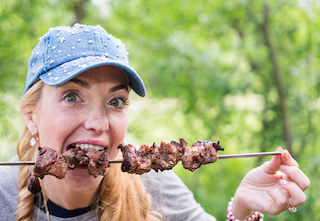 A few years ago, I wrote a post describing all the things that avowed Primal eaters can learn from plant-based or even vegan dieters. Sure, we’re diametrically opposed on the role of animal foods in human health, but there are still relevant takeaways.
A few years ago, I wrote a post describing all the things that avowed Primal eaters can learn from plant-based or even vegan dieters. Sure, we’re diametrically opposed on the role of animal foods in human health, but there are still relevant takeaways.
Carnivores are much closer to Primal eaters on the dietary spectrum, The Primal Blueprint posits that animal foods—meat, fish, fowl, shellfish, eggs, and dairy—represent the most nutrient-dense, most crucial component of the human diet. Carnivore takes that and runs with it, to its logical conclusion: Animal foods are so nutrient-dense and so important that we should eat them to the exclusion of everything else.
I don’t exactly agree, but I see where they’re coming from. And there’s a lot we can learn from the carnivore movement. I’ve got 8 takeaways today.
1. That a Steak Really Isn’t Going To Kill You
I’ve covered these arguments dozens of times on these pages. But it’s truly heartening to see hundreds and thousands of anecdotal reports from people who are thriving while eating two, three, four ribeyes a day for months and even years on end. When you see that, even though it’s “just” a collection of anecdotes, it gets really hard to think that eating a big grass-fed ribeye whenever you want is really going to give you cancer or diabetes or whatever else malady they’re trying to pin on red meat.
2. That More Fiber Isn’t Always the Answer
Of all the food components out there, fiber is the one that really trips me up. I still can’t quite get a handle on it. Is it important? Is it harmful? Is it useless? There’s conflicting evidence at every turn. My hunch—and reading of the anthropological and scientific literature—tells me that some prebiotic substrate is a good thing for healthy human guts, but it also tells me that fiber can be harmful in certain situations and in certain gut biomes. After all, we aren’t living like the Hadza, eating antelope colon sashimi and never touching soap. We live relatively sterile existences. Our guts are not ancestral, no matter how many quarts of kefir we quaff.
What carnivore offers is evidence that fiber isn’t always the answer. And remember that animal proteins can offer prebiotic substrate in the form of “animal fiber” (bones, tendons, connective tissue, gristle) and—if you consume dairy—milk oligosaccharides.
3. That Oxalates May Be An Issue
You know that strange feeling you get on your tongue and gums after a big serving of spinach? Those are oxalates, an anti-nutrient found in many if not most plant foods. They can bind to minerals and form crystals, the most infamous being the calcium oxalate crystals which are the most common type of kidney stone. Yeah, not fun.
The carnivore movement has seized on oxalates as a reason not to consume plants. Many animals have the adaptations to digest and nullify large amounts of oxalates. Humans, by and large, do not. There are exceptions, such as the Hadza whose guts harbor oxalate-degrading bacteria, and likely others yet to be discovered. And there’s definite variation even among humans living in industrialized settings—not everyone gets kidney stones because they ate creamed spinach. But it’s a good idea for the average human to at least be aware of oxalates.
Thanks to your newfound awareness of oxalates, you can figure out ways to reduce their impact if you still want to consume them.
You can ferment your foods. Lacto-fermented beets, for example, have lower oxalates than fresh beets.
You can choose low-oxalate plants. Kale is quite low in oxalates compared to other leafy greens, as are collard greens. Same goes for others in the brassica family, like broccoli, cabbage, and cauliflower: all low in oxalate.
You can improve your calcium metabolism. Eating enough vitamin A (retinol), vitamin K2, and vitamin D will improve your calcium metabolism and leave less of it hanging around to bind with oxalate and form crystals. Eating enough boron (or supplementing with it, as it doesn’t appear in many foods) can also reduce the formation of calcium oxalate stones.
Drinking about 4 ounces of lemon or lime juice in your water throughout the day will also reduce the formation of calcium oxalate stones.
I don’t mean for this to become a “what to do about oxalates” post. But without the carnivore movement’s broad transmission of the oxalate issue, many people wouldn’t even think about them.
4. That Meat Truly Is the Ancestral Foundation Of the Human Diet
I mean, we knew this. We knew that our hominid ancestors have been eating meat and marrow for over three million years. We knew that our meat-eating is probably what helped set us apart from our primate cousins, that calorie-dense and easily-digestible meat allowed us to shrink our guts and grow our brains. We knew that of all extant and known populations on earth, not a one was vegan.
But the carnivore movement makes you feel it. By eating exclusively meat and not just surviving but apparently thriving on animal foods alone, they force you into a reckoning of their historical primacy in the human diet. Now, not everyone thrives. The drop outs, well, they drop out. We only see the success stories—but that’s true for any diet, including Primal. The drop-outs from diets like Primal or carnivore tend to be less catastrophic and numerous than the drop-outs from veganism or fruitarianism, but they’re definitely out there.
5. That the Best Elimination Diet Might Be an All-Meat One
I wrote a post recently about the Autoimmune Paleo diet, a highly-restrictive but effective elimination diet used to identify trigger foods in autoimmune patients.
Going carnivore might just be a bare-bones version of the same thing. It eliminates all the same foods, plus more. And because it’s more of a scorched-earth approach, it’s simpler. You just eat meat and meat byproducts like bone broth, and nothing else. Such stark boundaries are somehow more digestible to a certain type of person. Less wiggle room, less to think about, less to get wrong.
That’s basically what Robb Wolf recently did to treat lingering gut issues: he ate meat and drank bone broth. For the full story, check out his recent appearance on Dr. Paul Saladino’s podcast.
6. That Phytonutrients Aren’t the Only Way To Induce Hormetic Stress
There are other ways to induce hormetic stress besides plant polyphenols. You can fast. You can exercise. You can expose yourself to cold or heat. You can expose yourself to “meat carcinogens” (yum). However, phytonutrients are good to have around. If you aren’t eating blueberries and broccoli because “those hormetic stressors aren’t the only game in town,” you’d better be doing the other stuff. You’d better be using the sauna, fasting, training hard (but smart), and going out into the cold.
7. That Strong Physical Performance Is Possible Without Tons Of Exogenous Carbs
You only have to look as far as Dr. Shawn Baker breaking rowing records, squatting 500 pounds for reps, and doing box jumps that would shame someone 30 years his junior to know that elite performance is possible—at least in one person—on a carnivorous, carb-free diet. It’s not “supposed” to be possible for anyone. Is Baker a genetic freak? Is he the only person for whom it’s true? I doubt it.
Now, glycogen is helpful. But you can manufacture glucose from amino acids and deposit it as glycogen, which you’ll be getting plenty of from all the protein you eat on a carnivore diet. This might not be the most efficient path for all elite athletes, but the carnivore movement shows that it’s at least possible for some.
8. How To Choose the Most Nutrient-Dense Animal Foods
There are the carnivores who eat steak and assume they’ve covered all their bases, and then there are the carnivores who eat steak and eggs and salmon and liver and kidney and marrow and mussels because they want to ensure they’ve covered all their bases. The former group will say something about “nutrient requirements going down on carnivore,” which may be true, but do all nutrient requirements drop across the board equally? Meanwhile, the latter group might agree with the former about nutrient requirements, but they’ll probably also want to be safer than sorrier. They can tell you all about the vitamin C content of fresh liver, the manganese in the mussels, the selenium in the kidney, the long-chained omega-3s in the salmon, the choline and biotin in the eggs, and the B-vitamins and creatine in the steak.
I’d listen to the latter group, personally. In figuring out the best way to obtain maximum nutrient density through animal foods alone, they can provide a roadmap to anyone who wants to include the most nutrient-dense animal foods in their omnivorous diet.
Diets aren’t ideologies. They aren’t religions. You don’t have to accept everything. You can pick and choose what works for you, especially if it actually works for you. You can heed these lessons contained in the post without actually going full carnivore, just like you could incorporate some of the lessons learned from vegans without going anything close to vegan.
Thanks for reading, everybody. What have you learned from the carnivore movement? Let me know down below in the comments, and have a good week.

The post 8 Things We Can Learn From the Carnivore Movement appeared first on Mark's Daily Apple.



December 3, 2019
The Case For Better Meat
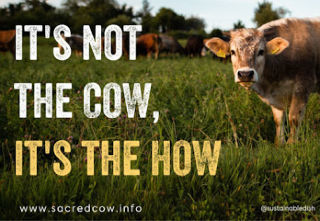 It’s Giving Tuesday, and while I know the world is full of good causes, today I’m highlighting one close to my heart. It’s one I’ve contributed to significantly because it matters on so many levels.
It’s Giving Tuesday, and while I know the world is full of good causes, today I’m highlighting one close to my heart. It’s one I’ve contributed to significantly because it matters on so many levels.
I’ve spent nearly 14 years working against the tide of misinformation out there around human health and agricultural agenda. Diana Rodgers has worked tirelessly and creatively for the same purpose. She’s just launched a crowdfunding campaign to finish what I think will be one of the most groundbreaking, revolutionary documentary films ever—one that has the power to turn the public conversation around health and ecology. But she needs support to finish and distribute this film, and that’s why I’m sharing her campaign today.
Read more and watch her video to see for yourself.
Diana’s film, Sacred Cow: The Case For Better Meat, details the movement toward the greatest revolution in agriculture—a regenerative food system that supports the human need for a nutrient dense diet and the ecologically sound farming methods that mirror and contribute to the natural health of the land itself.
Diana is a licensed, registered dietitian who’s spent the last 17 years living on a working organic vegetable and pasture-based meat farm, and all of her experience and study comes to bear in the film she’s created—a critical message that challenges the prevailing and destructive food system that undermines our individual health, our economic viability, and our environmental sustainability…and champions the intersection of nutrient dense food and regenerative food production for the good of human health and the good of the planet.
Below is Diana’s note. Watch the video. Read more on her site. Share her work and her crowdfunding campaign—and, if you can, contribute. Let me know what thoughts her work inspires for you. Thanks for reading today, everyone.
It’s official: I’ve just launched the crowdfunding campaign and I could really use your help!
As you know, I’ve been working super hard for the last three years on this project, without much of a break. It’s been a struggle at times, but it’s finally coming together – all because of you. Without you, this never would have happened! Thank you.
Please get in there and check out the new video with footage from the film, read about the film’s progress, pre-order my book, get a shirt, or pick up some meat!
SACRED COW CROWDFUNDING DEC 2019 from Diana Rodgers on Vimeo.
Research shows that campaigns that have early funding are the most successful, so if you’re planning on giving, I could really use your help today!
It would be incredible if everyone on this list would share with your friends and family. Let’s make this go viral!
All of the funds raised will go towards marketing the film so as many people as possible can access it easily. Click here to donate now.
Thank you so much for your support!
Happy Sunday,
Diana
P.S. If you were forwarded this email, please sign up here, so you can be the first to know of any updates (or fun campaign surprises!). I’d love to have you in this community!

The post The Case For Better Meat appeared first on Mark's Daily Apple.



December 2, 2019
I Enjoy My Life So Much More
It’s Monday, everyone! And that means another Primal Blueprint Real Life Story from a Mark’s Daily Apple reader. If you have your own success story and would like to share it with me and the Mark’s Daily Apple community please contact me here. I’ll continue to publish these each Monday as long as they keep coming in. Thank you for reading!

Yup, success stories are back! And I’m looking for more. Follow-ups, mid-progress reflections—every story at every stage has the potential to inspire folks out there who are getting started or contemplating a new beginning. Contact me here to share your story—long or not so long. You never know who you’ll impact by doing it. Enjoy, everyone!
Dear Mark, Thank you for asking for my contribution. And thanks for your unending support, inspiration and courage that you show everyday in your writing, your offering of healthy food, and your very presence.
I was a food addict. I was unhealthy. I didn’t really care.
Interestingly, I had Mark’s Daily Apple on my computer for years and never put it together that it was you or that it could be of any real help to me; some cool ideas….someday. When the stronger inkling of doing something about not feeling so well came up in me (age 65), it was the book Primal Blueprint that was there for me and that I was drawn to. Ultimately, I would need to lower my carbs even more to succeed at weight loss, but I am glad I started with your book because it talked about wonderful things like walking barefoot and volleyball on the beach with young studs. It got me feeling/thinking and opened my perspective on food and life.

The pictures above are the beginning middle and ongoing part of my keto/new lifestyle way of living. I now use fasting and lower carb eating to continue to sculpt and improve and perhaps lose a bit more. I think of it as reshaping and renewing now rather than aging.
I now kayak with people younger than me and train with a gyrotonic instructor a few hours a week. I am 19 months into my new journey.
 Once I made the decision and choice to do keto, and my body switched to burning fat as my fuel instead of carbohydrates, which for me took 3-4 months, when it became easy for me and has been a joy ever since. Let’s see…..eat this piece of bread or FEEL FANTASTIC. No chance, especially since I can have my own bread which I make with all organic ingredients.
Once I made the decision and choice to do keto, and my body switched to burning fat as my fuel instead of carbohydrates, which for me took 3-4 months, when it became easy for me and has been a joy ever since. Let’s see…..eat this piece of bread or FEEL FANTASTIC. No chance, especially since I can have my own bread which I make with all organic ingredients.
I enjoy my life so much more. Food is this glorious celebration after fasting for a bit. I continue to read and tweek things, and the adventure will never end.
This final picture is just for fun. I feel playful now and frisky. Not sure if the world is ready for me……..
Submitted with so much JOY!!!
Paula M.
September 2019
The post I Enjoy My Life So Much More appeared first on Mark's Daily Apple.



Mark Sisson's Blog
- Mark Sisson's profile
- 199 followers




